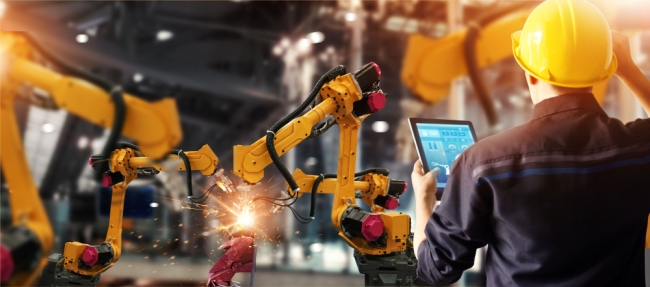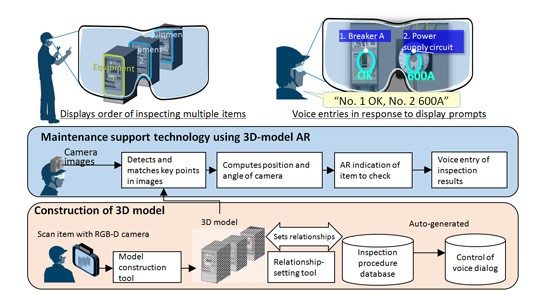John Himes is a tech writer who provides insights into the ways innovative technologies are coming together to revolutionize business, affect our daily lives, and alter our societies. In his free time, he enjoys DIY tech projects like Raspberry Pi.
Topics
How Augmented Reality & Immersive Tech Will Transform Future Manufacturing

The future of manufacturing is about more than smart, interconnected machines. To fully realize the benefits of industry 4.0, manufacturers need a new way to service, interface, and interact with their machines. It’s become increasingly apparent that tomorrow’s industrial human machine interfaces (HMIs) are lightweight wearables that enable users to tap directly into the digital world.
Augmented reality (AR) is that technology, and we’re already seeing industry leaders across the world adapt it for a variety of use cases. These include remote expert assistance, improved maintenance, virtual training, and complex manufacturing. Especially when combined, these augmented processes lead to increased plant throughput, better quality products, and greater personnel safety. Besides mitigating some of the hazards of heavy industry, we’re also seeing that AR is a crucial tech for COVID-19 era safety protocols.
In a July poll of 100 field service executives, a trend about continuity during the pandemic was uncovered. Those leveraging technology such as AR were 2.5x more likely to state that they were able to continue their 2020 plans with little impact to the business.
So, what is AR? K.R. Sanjiv writes for Industry Week, “Augmented reality is the fine line where virtual reality and reality meet. AR overlays virtual reality over real objects, providing all the necessary data a technician needs to make an assessment or perform a task.” Essentially, it means using devices like Microsoft HoloLens or DAQRI Smart Glasses to pull digital information into our field of vision without any standard input, such as a mouse or keyboard.
AR is picking up traction in business contexts. ARtillery Research estimates the global market for enterprise AR to reach $14.2B by 2022, and, according to a 2018 Harvard Business Review survey, “87% of respondents are currently exploring, piloting, or deploying mixed reality” while “68% of respondents believe mixed reality is important to achieving this companies’ strategic goals in the next 18 months.”
Even more recently, 1/3 of field service executives who responded to our July poll are actively investing in some combination of IoT, AR, and VR to optimize their operations as a result of COVID-19.
Now let’s dive into some of the ways that businesses are using AR to revolutionize manufacturing.
AR Manufacturing Use Cases
#1: Remote Expert Assistance
Let’s say you’ve got a problem. You were halfway through a print job, and suddenly your printer broke down. Unsure how to fix it, you call up the helpdesk. You try to describe the problem, they ask you some troubleshooting questions, and then they do their best to walk you through the solution over the phone. Chances are you’ve experienced something similar, and so you know how hard it can be to accurately convey this kind of technical information on a phone call.
Now imagine that the helpdesk technician could see through your eyes. They could tell you exactly which buttons to press, read error signals directly, and just be more efficient. Not only would this speed up the entire process, but it also saves you the headache.
Manufacturers are already doing this same process with AR by enabling technicians to instantly connect to experts via headset devices for remote guidance. In this way, a company’s most highly skilled engineers can manage multiple geographically distant facilities from the comfort of their own office. This is especially crucial for isolated production locations, such as mines or offshore oil rigs.
As an added feature, AR expert assistance also capitalizes on limited supplies of expert knowledge. “The much-lamented skills gap in manufacturing could have a technological solution in the form of augmented reality,” explains Ian Wright at Engineering.com. “Rather than training every technician or machinist, companies could use AR technology to supplement their employees’ existing knowledge with engineering expertise delivered via telepresence.”
#2: Maintenance
Another major use case is machine maintenance. By using AR glasses as an HMI on the plant floor, technicians receive instant, auto-generated service prompts directly from the machines. For instance, if a component in a robotic arm breaks or is on the verge of breaking, then it will display a 3D popup above it when the technician looks at it through their glasses. Essentially, this a way for machines to say, “Hey! I need some attention!”
Mitsubishi Electric is already using AR maintenance support technology to service everything from water-treatment plants to building electrical systems. Technicians receive visual AR indications of items to check, and from there they can respond directly with their voices.

This use case brings two main benefits. First, it reduces workloads by offloading inspection tasks from workers onto the machines itself. Rather than routinely checking for problems or waiting until something noticeably breaks, technicians receive service calls from the machinery, giving them a clear direction in which to focus their attention. Second, it provides a hands-free HMI that enables workers to keep their hands on the job while simultaneously guaranteeing high accuracy for voice log entries.
Essentially, AR maintenance boosts productivity by granting technicians fuller access to their machines’ digital environment.
#3: Complex Manufacturing
AR overlays can also assist workers in the manufacturing process itself, which is especially useful for building complex machinery with slim error margins. Technicians can access instruction manuals directly from their AR glasses, allowing them to keep their hands and attention on the job at hand.
AR overlays can also show step-by-step instructions on top of the machine itself. For instance, it could show where to fix a bolt or how to connect wiring by showing a digital representation of the process. This eliminates error and speeds up production.
Aerospace manufacturing is one industry that’s making huge progress with AR-enabled use cases. Boeing, for example, is using AR for digital 3D wiring diagrams on KC-46 tankers and 767 freighters. By the same token, Lockheed Martin is using AR to build F-35 fighter jets by using cameras, motion sensors, and depth sensors to add digital instructions and renderings on top of their real working environment. The result is a 96% accuracy bump and 30% faster production.
#4: Training
The final use case that we want to highlight is employee training. Instead of exposing trainees to high-risk production environments, companies can now use immersive technologies to provide life-like training in a controlled sandbox. Users can practice machine operation and maintenance on dummy machines with added AR, or they can even receive training from remote facilities in a fully virtual environment.
In the automotive industry, Ford is using AR to train technicians to service and maintain the electric Mustang Mach-E. “Technicians will be immersed in a simulated and gamified world, meaning that they won’t need to rely on Mustang Mach-E vehicles to learn about its components, including the electric SUV’s new high-voltage system,” said Ford’s service engineering operations director, Dave Johnson, in an article for Immersive Learning News. “This new virtual reality training tool allows technicians to understand the components and steps required to service these high-voltage systems, then confidently perform diagnostics and maintenance.”
And the results are tangible. CSG research concludes that performance by employees trained with AR is 150% better than those using paper-based training materials. Experience is the best teacher, and AR training gives technicians the experience that they need to get the job done from a safe and remote virtual training ground.
Measuring the Impact
We’ve narrowed in on three key performance indictors (KPIs) as metrics for a successful AR manufacturing strategy. By developing systems to test, measure, and optimize for these KPIs against a pre-AR baseline, companies can maximize their AR initiatives’ ROI.
First, we have throughput, which translates to making more products, servicing more machines, or even training more employees. Out of our three KPIs, this is the easiest to measure because it’s always a concrete unit: number of airplanes, barrels of oil, etc. Increasing throughput is the easiest way to see a fast return from AR.
Our second KPI is quality. While it can be more difficult to measure quality than quantity, it’s not news that technological innovation boosts quality of manufactured goods, and so we can certainly find ways to develop quality metrics. This could come from improved durability, greater market demand, or better performance.
Lastly, safety is our third KPI. All the use cases that we outlined above come together to create safer manufacturing. AR training ensures a safe training situation, while AR for maintenance and complex manufacturing reduce machine failures that are potentially hazardous. We can measure the safety KPI according to incident or downtime reduction.
AR for Manufacturing in the COVID-19 Era
Technology has proved crucial for business responses to COVID-19, but this goes well beyond remote workforce solutions to enable secure work from home. By its very nature, manufacturing is location dependent, and that means a number of employees have to show up on site for their jobs.
However, this also means companies are responsible for safety precautions like social distancing to minimize the risk of infection among their workforce. Mixed reality use cases are proving to be key players for manufactures to adapt to this "new working normal."
The AR assist and training use cases are the first place to start. By providing instructions and aid through an online AR platform, technicians can acquire the knowledge and skills that they need without having to come into close contact with anyone else.
The main problem is facilitating collaboration and knowledge transfer between veteran technicians and new technicians. In the pre-COVID world, this often meant mentoring or job shadowing, but this is no longer an option with social distancing. That’s where AR enters the picture: by using this technology for real-time communication between technicians, experts can remotely help more novice employees debug problems and resolve issues more quickly.
In this way, AR bridges skills gaps that could otherwise lower productivity, increase downtime, or lead to errors. It creates a seamless knowledge exchange for real-time collaboration without exposing anyone to COVID-19.
The Takeaway
Tomorrow’s manufacturing is already beginning to look very different than yesteryear’s industry. A confluence of technological breakthroughs create the conditions for smart factories, a product of the fourth industrial revolution and that are defined by unprecedented automation. The innovations driving this seismic shift include the industrial internet of things (IIoT), machine learning (ML), cloud computing, and other similar technologies.
By integrating information technology (IT) with operational technology (OT), we’re watching the physical and digital worlds converge on the factory floor. Augmented reality is our window into that new world. It’s the HMI that today’s technicians need to install, configure, and support this new class of connected smart machines.
It’s no wonder that Statista estimates the AR market will grow from $5.91B in 2018 to more than $198.7B by 2025. AR is a key component in the formula for a successful transition into industry 4.0.
Ready to join the forward-thinking leaders who are pioneering the way? Learn more about how CSG’s Teamwork AR can help.
John Himes is a tech writer who provides insights into the ways innovative technologies are coming together to revolutionize business, affect our daily lives, and alter our societies. In his free time, he enjoys DIY tech projects like Raspberry Pi.

